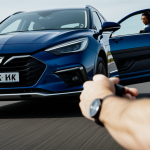Fundamentals of Lane-Keeping Assist Technology
Lane-keeping assist (LKA) is a pivotal driver assistance system designed to enhance vehicle safety by helping maintain lane discipline. At its core, the LKA system functionality relies heavily on a combination of cameras, sensors, and electronic control units (ECUs) to consistently monitor lane markings and the vehicle’s position relative to them.
The primary principle behind lane-keeping assist is the continuous analysis of visual data captured through forward-facing cameras. These cameras detect lane boundaries by recognizing painted lines on the road surface. Along with sensors, such as lidar or radar on some models, the system processes this information through the ECU, which then determines if the vehicle is unintentionally drifting from its lane. Upon detecting such deviations, the system can either alert the driver via visual or auditory warnings or apply subtle steering corrections to guide the vehicle back on track.
Have you seen this : Enhance Your Vehicle’s Safety: The Complete Handbook for Mastering Your Automatic Emergency Braking System
Standard features found in UK vehicles equipped with lane-keeping assist typically include:
- Lane departure warnings to alert drivers before an unintended lane change occurs.
- Mild steering inputs to correct minor drifts without requiring driver intervention.
- Adaptive sensitivity levels to adjust how aggressive the system responds based on driving conditions.
By integrating these components, the LKA system functionality aims to mitigate common causes of accidents related to lane departure, such as driver distraction or fatigue. This layered approach allows lane-keeping assist to operate as a seamless extension of the driver’s control, promoting safer road use in diverse driving environments.
This might interest you : Mastering Vehicle Safety: Key Strategies for Accurate Calibration of Collision Avoidance Technology
Recognising and Managing Rural UK Road Challenges
Rural road driving presents unique challenges for lane-keeping assist systems. Unlike urban roads, rural UK roads often feature lane marking challenges that significantly affect the LKA system functionality. For example, fading or absent lane markings due to wear or less frequent maintenance undermine the system’s ability to accurately detect lanes, increasing reliance on sensor input and camera clarity.
Narrow carriageways typical of rural areas intensify the difficulty. The limited space leaves less margin for error, so the driver assistance systems must respond swiftly to ensure the vehicle stays correctly within its lane. Sharp bends are also prevalent, demanding higher precision from the cameras and electronic control units (ECUs). These maneuvers test how well the system interprets curved lane lines versus straight segments.
Seasonal changes and weather conditions further impact performance. Rain, fog, and low light reduce camera visibility and may obstruct sensors, compromising the LKA system functionality. Additionally, roadside hedges, debris, and inconsistent or missing signage in rural locations create visual distractions or confuse the system’s lane recognition algorithms.
Given these factors, effective lane-keeping assist on rural UK roads relies heavily on advanced sensor fusion, robust camera systems, and adaptive ECUs capable of compensating for fluctuating environmental variables. Understanding these rural road driving challenges is essential for appreciating the limitations and capabilities of LKA in such settings.
Step-by-Step Guide to Adjusting Vehicle LKA Settings for Rural Roads
Fine-tuning vehicle settings adjustment for lane-keeping assist (LKA system functionality) is crucial when driving on rural UK roads, where lane marking challenges and environmental variables demand heightened system responsiveness.
First, camera calibration is essential. A precise calibration aligns cameras and sensors to reliably detect lane boundaries, even when markings are faded or irregular. Manufacturers typically recommend performing calibration after windshield replacements, sensor cleaning, or software updates. Using built-in vehicle menus or diagnostic tools, drivers can confirm calibration status and initiate adjustments if needed.
Next, LKA sensitivity settings should be tailored for rural road driving. Most UK vehicles equipped with lane-keeping assist offer sensitivity customization, allowing drivers to define how early or aggressively the system intervenes. Increasing sensitivity helps the system respond sooner to subtle lane drifts common on narrow carriageways, while reducing it might prevent frequent false alerts caused by uneven or missing markings.
Drivers benefit from adjusting warning thresholds alongside sensitivity. Setting clearer, more noticeable visual or audible alerts ensures timely attention on roads with complex bends or obstructed views. For example, increasing alert volume or enabling prolonged warning durations can enhance safety on sharp rural bends where reaction time is critical.
Different UK vehicle models—such as Ford, Vauxhall, Volkswagen, and Toyota—offer specific sequences or menus for these adjustments. While interface details vary, the underlying principles of camera calibration and sensitivity tweaks remain consistent across brands. Consulting the vehicle manual or onboard assistance screens aids efficient, accurate configuration.
By systematically calibrating cameras, refining LKA sensitivity settings, and customizing warnings, drivers can significantly improve driver assistance systems performance in rural environments. This step-by-step approach fosters safer navigation and maximizes the benefits of lane-keeping assist amid the challenges posed by rural UK roads.
Troubleshooting and Optimising Lane-Keeping Assist in Real Conditions
Lane-keeping assist (LKA troubleshooting) in rural environments requires understanding common issues such as false alerts and missed lane markings—problems frequently encountered on rural UK roads. False alerts often arise when the system misinterprets faded or irregular lane lines, roadside hedges, or shadows as lane boundaries. Conversely, missed lane markings occur when cameras or sensors fail to detect worn or obscured lines, leading to delayed or absent steering corrections.
To address these challenges, drivers can temporarily override the LKA system functionality by applying manual steering inputs. This intervention prevents unwanted corrections and allows the driver to maintain full control, especially in areas where lane markings are unreliable. Additionally, fine-tuning vehicle settings adjustment—such as lowering sensitivity or adjusting warning thresholds—helps reduce interruptions caused by inconsistent rural conditions.
Effective troubleshooting also involves regular inspection and cleaning of cameras and sensors. Dirt, mud, or water droplets can degrade sensor accuracy, amplifying detection errors. Periodic calibration, as described previously, ensures sensors and cameras remain aligned for optimal performance in fluctuating outdoor environments.
Practical rural road driving tips include reducing reliance solely on automated systems in complex scenarios, such as sharp bends or narrow roads where driver assistance systems may struggle. Experienced rural drivers recommend combining active monitoring with trusted LKA features to maintain safety without overdependence.
Real-world examples highlight success stories where proper calibration and judicious use of adjustments significantly improved lane-keeping on challenging rural routes. However, recurring pitfalls involve neglecting regular system updates or ignoring sensor obstructions, which degrade LKA reliability.
In conclusion, effective system optimisation integrates proactive troubleshooting with informed driving practices, empowering drivers to maximise lane-keeping assist benefits amid rural UK road complexities.
Evaluating System Compatibility and Upgrades for UK Drivers
When considering LKA compatibility, it is crucial to assess whether a particular UK vehicle model offers the necessary hardware and software to support effective lane-keeping assist on rural roads. Popular models such as Ford’s Kuga, Volkswagen’s Golf, and Toyota’s Corolla commonly feature advanced driver assistance systems designed with adaptable ECUs and sophisticated sensor arrays. These systems enhance lane recognition in environments with lane marking challenges typical of rural UK roads.
Many vehicles come equipped with factory-installed LKA systems that integrate seamlessly with existing safety suites, ensuring reliable performance even when lane markings are faded or intermittently absent. Evaluating a vehicle’s baseline LKA functionality involves verifying sensor types, camera resolution, and the ECU’s processing capabilities. Higher-end models often incorporate sensor fusion, combining radar, lidar, and camera inputs for superior lane tracking accuracy.
For vehicles lacking comprehensive LKA features, aftermarket upgrades present a viable option. These upgrades typically include advanced camera modules and software packages that can be installed to enhance rural road driving safety. However, compatibility checks are essential before installation, as not all upgrades align with every vehicle’s electrical architecture. Software updates from manufacturers also improve LKA system functionality by refining lane detection algorithms and expanding the system’s ability to interpret complex rural road scenarios.
Experts recommend drivers stay informed about emerging LKA technologies tailored for rural use. Innovations focused on adaptive learning and enhanced environmental sensing promise to bridge current limitations. By choosing compatible vehicles and staying proactive with upgrades, UK drivers can significantly improve their driver assistance systems effectiveness in rural settings.











